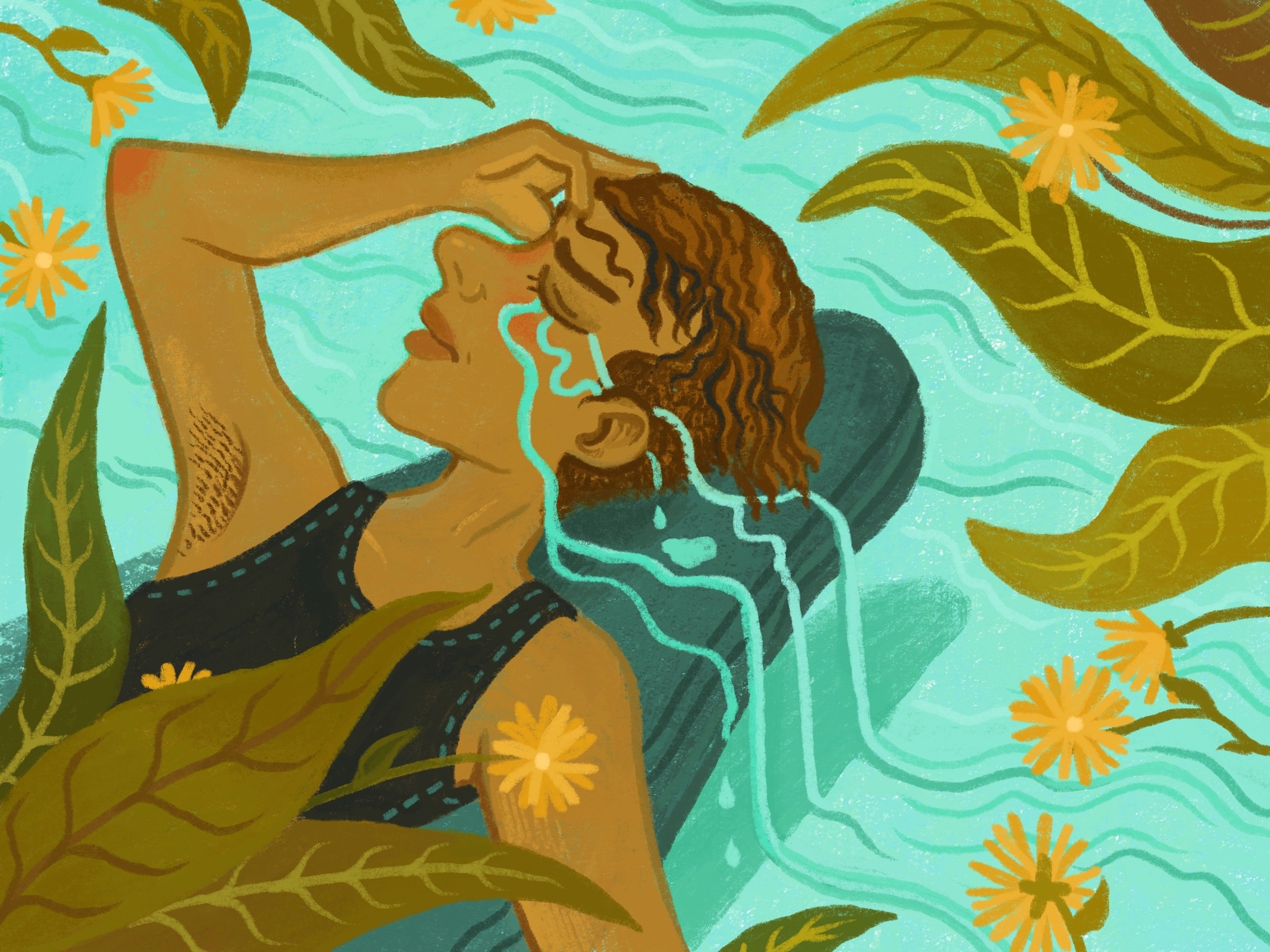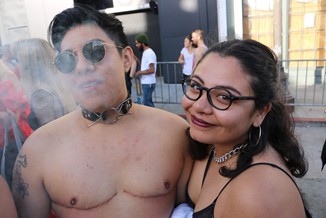Photo by Eli Sleepless
[CN: self-injury, substance use]
There are many valid reasons to self-harm. If there weren’t, so many of us wouldn’t struggle with various self-destructive behaviors. But we do struggle. And one thing is for sure: silence on the subject doesn’t help.
Silence leaves people feeling as though they’re doing something wrong for trying to survive with the tools they have.
When people are shamed out of causing harm to themselves in ways that appear obvious, such as cutting, it doesn't resolve the deep-seated issue. If underlying emotions go unchecked, the same patterns will circle back around. Stop engaging in one action, and another one will pop up instead.
Shame can drive us to self-harm and hide it, even make the behaviors look "successful" like becoming a workaholic or over-exercising.
Almost any activity can be used for self-harm or self-care. The difference is about our individual relationship to the thing. In order to harm ourselves less and care more, we need to look at our relationship with the world around us.
The problem isn’t how we’re hurting ourselves, but that we’re hurting ourselves at all.
Oppression Leads to Self-Harm
We’re inundated every day with reminders that certain identities hold less value in society. And just as we don’t choose our identities, we don’t choose to be impacted by related microaggressions on an emotional level. One of many ways we feel this impact is through self-harm, whether that’s obvious like self-injury or more hidden like engaging in destructive behaviors.
Any expression of surviving oppression, including self-harm, can be turned around to blame the victim. That way we judge ourselves for self-injury and self-destruction? That’s because of victim-blaming.
The intended result of blaming victims, whether it’s systemic or interpersonal violence, is to leave vulnerable people with unnecessary shame – the burden others should take as accountability, but instead leave survivors of violence to pick up and shoulder.
We’re shamed by society into believing who we are isn’t valuable, or we’re inherently a burden or problem for others, that perhaps we shouldn’t even exist. It teaches us to believe we’re unworthy of support, making it harder to rely on methods of coping that truly heal – which are often inaccessible anyway to those who are poor, trans, queer, persons of color, and/or sex workers.
Abuse survivors and marginalized people often self-harm because we're sent messages that we don't deserve to live or can’t have a successful life. We’re taught that we’re worth “less” – in other words, worthless – and that using resources for ourselves is a waste.
Without other options, emotionally and financially, we often take the pain shoved onto us by others out on ourselves.
Not only can this lead to self-injury, but many of our choices and actions are driven by self-destruction as well. Drinking too much, isolating, underselling our skills, sabotaging relationships, not asking for help when we need it, overspending, and on and on.
When I was 15, I took up smoking cigarettes because I thought they would slowly kill me. It was like how many ticking time bombs can I set up in my life? Since then I’ve quit the nicotine habit (twice), but I’ve learned many times over that removing one tool of self-harm doesn’t end the entire behavior.
Releasing Shame around Self-Harm
These aren’t issues we can resolve overnight. To start, it’s important to recognize that it’s not our fault that we’re wrestling with self-destructive thoughts in the first place.
Self-harm of any kind doesn’t happen because a person is too “weak” to cope. It is a valid way to deal with what’s going on, a way to redirect overwhelming feelings. Sometimes self-injury can even be enjoyable and provide a sense of relief.
If any method of coping helps you get through the day, that’s what matters for your short-term needs. We shouldn’t see physical self-harm as any different than drinking after a stressful day. It may not be ideal, but there’s a spectrum of engaging in substance use, just as there’s a range of potential harm in self-injury from minimal risk to potentially life-threatening.
As a teenager, I physically self-harmed in a few ways, and that always helped in the moments when it felt necessary. It would snap me out of intense states of derealization and paranoia. But my mom, like many moms, took it as a sign of her own failure as a parent. She couldn’t focus on my pain or challenges, only how that reflected on her image.
But if your kid or partner or friend is self-harming, that’s about so many complicated things. Shaming someone into no longer cutting doesn’t address whatever drove the person to that point in the first place. It only creates one more complicated aspect of life to navigate while carrying our already-heavy emotions.
Complex things are happening in the moment. Self-harm can be a reaction to a surge of emotions we can't process all at once, an act of expression – like throwing a bottle at the wall to witness the glass smash, only we’re directing that energy at ourselves. That’s the surface level. Below that, many marginalized people (self included) are expressing internalized messages of what the world thinks of us.
There are times when I’m depressed and know exactly what I should do but avoid doing it, and deep down I know the only reason is self-destructive. In that way, procrastination and especially neglecting self-care can be ways I'm repeatedly harming myself. It’s not intentional, but it happens and can snowball.
Skipping on the things that I know are healthy means I often self-medicate anxiety with alcohol instead. Drinking isn’t always an act of self-harm in my life. But when it leads to avoiding responsibilities, including other things I want to do to feel joy like cooking or exercising, then for me it is.
Of course I can’t speak for others’ relationships to substance use, physical self-injury, or general self-destructive tendencies. But what I can say is, no matter what situation you’re in, it helps to know your own limits and how to keep yourself within them.
Harm Reduction as We Heal
It took a while for all these feelings to build up in the first place, so it will take a while to address them. In any healing or self-care plan, a key part is setting realistic expectations.
Harm reduction practices are all about realistic expectations.
They’re a short-term solution to help you keep going right now while you work toward sustainability. With a comprehensive healing plan, which sounds fancy but just means you aren’t putting all your eggs in one basket, it’s possible to feel less stress, more joy over time.
There shouldn’t be shame about how we cope, and there also shouldn’t be shame around who we are. With the right harm reduction model for you, hopefully you’ll feel less shame around both. And if you aren’t finding anything perfect for your situation, then adapt existing harm reduction strategies to fit your needs. It’s all about honoring your individual limits and, most of all, honoring yourself.
Related Resources:
Harm Reduction as a Tool for Radical Self-Love
Alcohol Harm Reduction Cheat Sheet
Tits and Sass: Ask Ms. Harm Reduction
HIPS, harm reduction by U.S. CDC
Lower East Side Harm Reduction Center
Principles of Harm Reduction (for substance use)
We need community support to continue publishing!
Articles and artwork like these are only possible through your contributions. Please donate today to sustain the wellbeing of artists, writers, healers, and LGBTQ2IA+ people of color.
You can also support our team by picking up
a Rest for Resistance print zine.
Image description:
Two forearms are held up to the camera, hands balled into fists. Different scars are displayed on each, including cut marks and circular scars. The right side of the light-skinned person's head is shown, but not the face. They have short, dark hair and are wearing a black t-shirt.
About Dom Chatterjee:
The editor-in-chief of Rest for Resistance and founder of QTPoC Mental Health, Dom believes in the power of community to combat oppression. Dom is a non-binary desi-dutch-american person living with multiple disabilities.
About Eli Sleepless:
Eli Sleepless is a self-taught latinx film photographer. Their genderqueerness and nyc upbringing is important to their work. Find more of their work on tumblr, instagram, facebook, and our main page.










